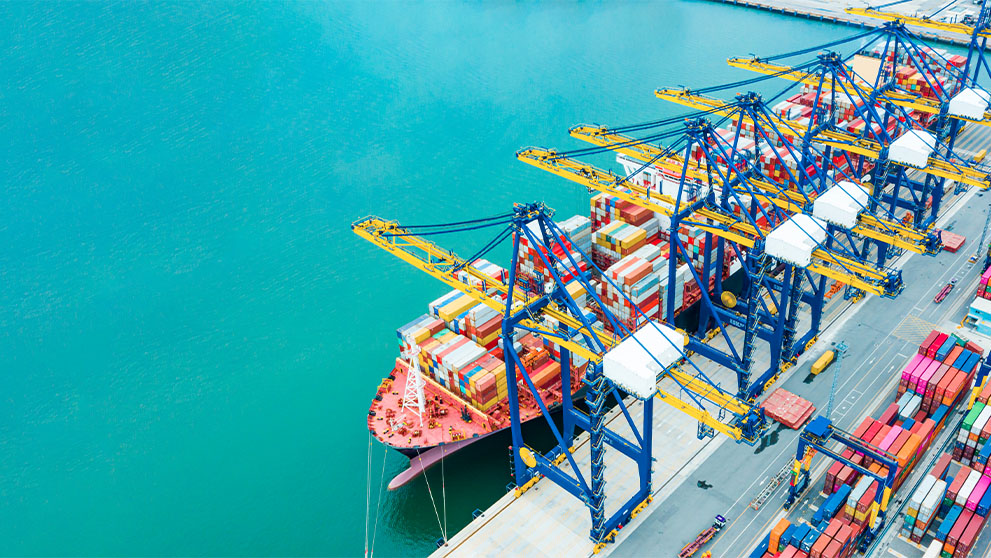The world of logistics can feel like a maze of jargon and acronyms. This glossary is your key to unlocking clear communication and navigating the complexities of international shipping with confidence.
The world of international shipping relies on specialised terminology to ensure smooth and efficient operations. While this language may seem daunting at first, understanding important logistics terms can empower businesses to communicate effectively with their shipping partners, optimize their supply chains, and navigate the complexities of global trade with confidence.
At DHL Express, we believe in empowering our customers with the knowledge they need to succeed. This glossary demystifies common logistics terms, providing clear and concise explanations to enhance your understanding of the language of shipping. Whether you're a seasoned exporter or just starting your international shipping journey, this guide will serve as a valuable resource, equipping you with the terminology needed to navigate the world of logistics with clarity and confidence.
1. A – C
A Latin term meaning "according to value," often used to describe taxes or duties calculated as a percentage of the value of goods or services.
A protectionist tariff imposed on imports that are sold at a price lower than their domestic market value, potentially harming domestic industries.
Also referred to as the “passport for goods”, the ATA Carnet is an international customs document that allows duty-free and tax-free temporary import of goods for exhibitions, trade shows, or professional use.
A certification granted to businesses that meet specific supply chain security and compliance standards, facilitating faster customs clearance and trade facilitation.
An electronic system used by U.S. exporters to electronically file export information to the Census Bureau, streamlining the export process and improving data accuracy. Businesses exporting goods requiring an export license or valued at over US$ 2,500 are expected to register through AES.
A German customs software used for electronic customs declaration and processing, facilitating efficient customs clearance and trade.
A customs document used to grant preferential rates of duty (often zero), facilitating ease of movement of goods between the European Union (EU) and Türkiye.
A document that serves as a contract between the shipper and the airline, providing detailed information about the shipment and its transportation, including the origin and destination, shipper and consignee details, a description of the goods, quantity, weight, dimensions, and applicable freight charges.
Obstacles that prevent new businesses from entering a particular market, such as high startup costs, regulatory hurdles, or strong competition from well-established businesses.
A legal document issued by a carrier to a shipper, acknowledging receipt of cargo for transport. It serves as a contract of carriage, outlining the terms of transportation, including details about the goods, their destination, and the responsibilities of both the shipper and the carrier. It also acts as a document of title, allowing the consignee to claim the goods upon arrival.
The address where a business sends invoices and billing statements for a transaction. This may be different from the shipping address, especially in cases where the recipient of the goods is not responsible for payment, or when the goods are shipped to a different location than the billing party.
Goods that are stored in a bonded warehouse or under customs control, where duties and taxes are deferred until the goods are released into circulation.
The process of scheduling a pickup for a shipment, typically initiated by the shipper with a logistics provider like DHL Express. This involves providing details about the shipment, such as its size, weight, destination, and desired pickup time. DHL Express integrates this functionality into its online platforms and customer portals, allowing businesses to easily book collections and manage their shipments seamlessly.
A designated point of entry that’s located on the outside borders of EU member countries where customs officials and veterinary inspectors inspect animals, animal products, and related documents. This is done to ensure compliance with import and export regulations, including health and safety standards.
Cargo that is transported in individual pieces or packages, rather than in standardised containers, often requiring specialised handling.
An individual or company that acts as an intermediary between importers or exporters and customs authorities. They assist with customs clearance procedures, ensuring compliance with regulations, preparing necessary documentation, and facilitating the smooth flow of goods across borders. Brokers often have specialised knowledge of customs laws and procedures, helping businesses navigate the complexities of international trade.
A document listing the contents of a shipment, including details about each cargo item, its weight, dimensions, and destination. It may be used as an alternative to a cargo declaration.
An Incoterm where the seller is responsible for the carriage of goods to a named destination, but the risk transfers to the buyer once the goods are handed over to the carrier.
Similar to a CPT, but the seller is responsible for both the carriage and insurance of the goods to the named destination. The risk still transfers to the buyer when the goods are handed over to the carrier.
A document certifying the origin of goods, often required for preferential tariff treatment or to comply with trade regulations. It declares where the goods were manufactured and can be obtained by applying at a local Chamber of Commerce.
There are two types of Certificates of Origin: preferential and non-preferential. The preferential Certificate of Origin certifies that goods meet specific criteria to qualify for reduced or zero tariffs under Free Trade Agreements. The non-preferential Certificate of Origin simply confirms the origin of the goods with no preferential tariff treatment.
An Incoterm where the seller is responsible for the cost and freight of goods to a named port of destination, but risk transfers to the buyer once the goods are on board the vessel.
An Incoterm where the seller is responsible for cost, insurance, and freight to a named port of destination, but risk transfers to the buyer once the goods are on board the vessel.
An economic model focused on minimising waste and maximising resource utilisation through reuse, repair, and recycling.
An international agreement regulating the trade of endangered species to protect wildlife from over-exploitation.
A legal document between the seller and buyer outlining the transaction details, including description of goods, quantity, price, and terms of sale. This declaration is used to assist customs authorities in calculating the taxes and duties due. It also contains the shipment’s Incoterms, which are used to inform authorities who they should collect the fees from.
A document required by some countries for import clearance, certified by the consulate of the importing country in the exporting country.
A company or person engaged in the express delivery of packages and documents, often specialising in time-sensitive or high-value shipments.
A prediction of the net profit attributed to the entire future relationship with a customer, important for businesses to understand long-term customer value.
A financial guarantee, often in the form of a bond or insurance policy, that importers or their customs brokers may be required to post with customs authorities. This guarantees that all duties, taxes, and fees associated with the imported goods will be paid in full. It acts as a security measure for customs authorities, ensuring that they receive the necessary payments even if the importer fails to fulfil their financial obligations.
The process of obtaining permission from customs authorities to import or export goods, involving documentation, inspection, and payment of duties and taxes.
A formal document submitted to customs authorities, providing details about a shipment and its contents for import or export clearance.
Also known as Import Duty, customs duty is a tax levied on goods transported across international borders, typically calculated based on the value, type, and origin of the goods.
The various documents required for customs clearance, including commercial invoices, packing lists, certificates of origin, and customs declarations.
A unique code assigned to goods for classification and determination of customs duties and taxes.
2. D – F
An Incoterm (International Commercial Term) where the seller is responsible for delivering the goods to a specified destination, typically a named place in the buyer's country. The goods are delivered ready for unloading, meaning the seller bears the costs and risks associated with transportation to that point. However, the buyer is responsible for unloading the goods, handling import clearance, and paying any applicable duties and taxes.
An Incoterm where the seller is responsible for delivering the goods to a specified place, typically in the buyer's country, and for unloading the goods from the arriving means of transport. This means the seller not only bears the cost and risk of transport, but also the unloading. Similar to DAP, the buyer is responsible for import clearance and any associated costs, such as duties and taxes.
An Incoterm where the seller is responsible for all costs and risks associated with delivering the goods to the named place in the buyer's country. This includes not only the cost of transportation but also all export and import clearance procedures, duties, and taxes. Essentially, the seller handles everything involved in getting the goods to the buyer's doorstep.
An Incoterm where the seller is responsible for delivering the goods to a named place in the buyer's country, but the buyer is responsible for import clearance and any associated costs, such as customs duties and taxes. This means the seller bears the risk and cost of transportation to the named place, but the buyer takes on the responsibility and cost of importing the goods into their country.
Sometimes referred to as the Importer of Record, the declarant is the person or entity making a customs declaration, typically the importer or exporter or their authorised representative. They’re responsible for making sure that all customs compliance requirements are met on a cross-border shipment.
A statement indicating the origin of goods, often included in the commercial invoice or a separate document.
A charge levied by a carrier for delays in loading or unloading cargo beyond the agreed-upon time, typically applied to shipping containers.
A value threshold set by a country's customs authorities. If the value of an imported shipment is below this threshold, it may be exempt from customs duties and taxes. This provision is often applied to low-value shipments, such as small packages or personal gifts, to simplify customs procedures and reduce administrative burden for both customs officials and importers. De minimis thresholds vary significantly from country to country.
A detailed description of the goods being shipped, including their type, quantity, and any relevant specifications, required for customs clearance and documentation.
A shipment consisting only of documents, such as contracts, invoices, or certificates, often subject to different shipping regulations and rates than non-document shipments.
A retail fulfillment method where a store doesn't keep the products it sells in stock. Instead, when a store sells a product, it purchases the item from a third party and has it shipped directly to the customer.
Goods that can be used for both civilian and military purposes, often subject to export controls and licensing requirements.
The electronic exchange of business documents between trading partners in a standardised format, improving efficiency and accuracy in supply chain communication.
Documents required for customs clearance of imported goods, including commercial invoices, packing lists, certificates of origin, and customs declarations.
A prohibition on trade with a particular country or region. Embargoes can be imposed by governments for political or security reasons, but they can also be imposed by individual companies or organisations based on their own policies or risk assessments. Embargoes typically restrict the flow of goods, services, or financial transactions with the targeted country or region.
A unique identification number assigned to businesses involved in international trade within the EU. It’s mandatory for businesses looking to trade internationally in the EU.
An Incoterm where the seller makes goods available at their premises, with the buyer responsible for all transportation and export clearance costs.
A tax levied on specific goods produced or sold within a country, often applied to goods like alcohol, tobacco, or fuel. These duties are typically imposed to generate revenue, discourage consumption of certain goods, or regulate industries. While businesses may initially pay the excise duty, these costs are usually passed along to consumers in the form of higher prices.
Goods imported for exhibitions, trade shows, or demonstrations, often eligible for duty-free entry under specific customs procedures.
A premium shipping service that guarantees faster delivery times than standard shipping, often used for time-sensitive or urgent shipments. Expedited delivery typically involves faster transportation modes, such as air freight, and prioritised handling to ensure quick delivery.
The process of sending goods or services from one country to another for sale or trade.
The act of producing goods in one country and selling them to another country.
A document that accompanies export shipments from EU countries to non-EU countries. This document provides information about the goods and their destination for customs clearance and tracking.
A shipment of goods sent from one country to another on the basis of an export contract.
A formal document submitted to customs authorities, providing details about an export shipment for clearance and regulatory compliance.
A government authorisation required for the export of certain goods, often imposed for reasons of national security, economic protection, or public health.
An Incoterm where the seller delivers goods alongside a vessel at a named port, with the buyer responsible for loading and onward transportation costs.
Within e-commerce, first-mile delivery is the first stage of the transportation process, typically from the point of origin (e.g., a warehouse or factory) to a transportation hub or carrier facility.
A pricing model where a fixed shipping fee is charged regardless of the shipment's weight or distance, often used for smaller or standardised packages.
An Incoterm where the seller is responsible for delivering the goods onto the vessel nominated by the buyer at the named port of shipment. This means the seller clears the goods for export and delivers them to the ship, at which point the risk and responsibility for the goods transfer to the buyer. The buyer then bears all costs and risks associated with the onward transportation of the goods to their final destination.
A logistics model where a fourth-party logistics provider manages and integrates all aspects of a company's supply chain, including logistics services, technology, and consulting.
An Incoterm where the seller delivers the goods to the carrier or another person nominated by the buyer at the seller’s premises or another named place. Once the goods are handed over to the carrier, the risk and responsibility transfer to the buyer. The buyer then bears all costs and risks associated with the onward carriage of the goods.
A designated area within a country where goods can be imported, stored, and processed without being subject to customs duties or taxes.
3. G - L
A detailed description of the goods being shipped, including their type, material, quantity, and any relevant specifications, required for customs clearance and documentation. This is often required on a shipment’s Commercial Invoice and Air Waybill.
Fees charged for the physical handling of cargo, including loading, unloading, storage, and movement within a warehouse or transportation hub.
An internationally standardised system of names and numbers for classifying traded products, used by customs authorities for tariff classification and data collection.
A shipment of goods brought into a country from another country for import, typically consisting of multiple packages or items.
A tax levied on goods imported into a country, calculated based on the value, type, and origin of the goods. This amount differs from country to country.
A government authorisation required for importing specific goods into a country, often imposed for reasons of economic protection, public health, or safety.
A consumption tax that’s added to the value of goods and services at each stage of production and distribution. When goods are imported, Import VAT is typically applied at the point of entry into the country, and it's calculated based on the value of the goods, including any customs duties and other import charges. The importer is responsible for paying the Import VAT to customs authorities.
A sustainability practice where businesses invest in carbon reduction projects within their own supply chains or value chains, rather than relying solely on offsetting. An example includes DHL’s GoGreen Plus, where we invest in sustainable aviation fuel (SAF) to reduce carbon emissions within our own operations, allowing customers to directly contribute to these efforts by choosing GoGreen Plus services.
The movement of goods using multiple modes of transport, such as sea, rail, and road, under a single contract, offering flexibility and efficiency in logistics.
Expenses associated with holding and managing inventory, including storage, handling, insurance, and obsolescence costs.
A commercial document issued by a seller to a buyer, providing details about a transaction, including description of goods, quantity, price, and payment terms.
The total cost of a product once it has arrived at its destination, including purchase price, shipping costs, customs duties, taxes, and other associated fees.
The process of planning, implementing, and controlling the efficient and effective flow and storage of goods, services, and related information from the point of origin to the point of consumption. It encompasses a broad range of activities, including transportation, warehousing, inventory management, packaging, and order fulfilment. Logistics plays a crucial role in supply chain management, ensuring that goods are delivered to the right place, at the right time, and in the right condition.
4. M – P
A customs document used to certify the origin of goods and their eligibility for preferential rate of duty under specific bilateral trade agreements.
The use of multiple modes of transport for efficient and cost-effective movement of goods, often involving seamless integration of different carriers and logistics providers.Item Text 2
A shipment that contains physical goods, such as products, samples, equipment, or merchandise. Non-document shipments are often subject to different shipping regulations, customs procedures, and shipping rates compared to document shipments due to their physical nature and potential import or export restrictions. These goods will require a Commercial Invoice.
Goods originating from countries outside a specific customs union or trade bloc, often subject to different tariff rates and customs procedures. Unlike Union Goods, Non-Union Goods will be subject to customs supervision.
A delivery service that allows customers to choose their preferred delivery time and location, offering flexibility and convenience in e-commerce fulfillment.
A shipment that is part of a larger order, delivered in multiple installments, often used for large or complex orders.
The digital exchange of trade documents, replacing traditional paper-based processes. It leverages technology to streamline documentation, improve efficiency and accuracy, and reduce the environmental impact associated with paper consumption and transportation.
A fixed fee that some businesses, particularly in e-commerce, charge for each order they process, regardless of the order's value or the quantity of goods included. This fee is often used to cover the costs associated with order processing, handling, and fulfillment, such as picking, packing, and shipping the order. It can be a separate charge in addition to shipping fees or may be included in the overall shipping cost.
A government agency that collaborates with customs authorities to regulate and enforce import and export controls, such as those related to food safety, health, or environmental protection.
A designated location where goods are imported into a country, typically a seaport, airport, or border crossing, where customs clearance procedures take place.
A reduced tariff rate applied to goods originating from specific countries or regions, often granted under trade agreements or preferential trade programmes. To claim this rate, shippers will need to submit Proof of Origin.
A preliminary invoice sent to a buyer before the shipment of goods, providing an estimate of the transaction details and facilitating payment or financing arrangements.
5. R – Z
Goods that are returned to the seller due to defects, damage, or customer dissatisfaction, often requiring specific logistics and customs procedures for handling.
The process of managing the return of goods from the customer back to the seller or manufacturer, including activities like collection, inspection, and refurbishment.
The process of verifying that parties involved in a transaction are not subject to international sanctions or trade restrictions, ensuring compliance with regulatory requirements.
The monetary value assigned to a shipment of goods, declared by the shipper on the Commercial Invoice. This value is used by customs authorities for various purposes, including assessing customs duties and taxes, determining insurance coverage, and collecting trade statistics. Accurate declaration of shipment value is crucial for compliance with customs regulations and to ensure proper valuation for insurance purposes.
Charges for storing goods in a warehouse or distribution centre, typically calculated based on the storage space used and the duration of storage.
An additional fee added to the base shipping rate, often applied for special services, fuel price fluctuations, or peak season demand.
A unique code assigned to goods for classification and determination of customs duties and taxes, based on the Harmonised System (HS) nomenclature.
Quantitative restrictions on the import of specific goods, limiting the quantity that can be imported at a preferential tariff rate.
Compulsory financial charges imposed by governments on individuals or businesses, including income tax, sales tax, and value-added tax.
A logistics model where a company outsources logistics services to a specialised provider, such as transportation, warehousing, or customs brokerage.
Goods originating from countries within a specific customs union or trade bloc, often subject to preferential tariff treatment and simplified customs procedures.
A document that provides detailed information about a shipment, including its origin, destination, contents, and carrier information, often used for tracking and customs clearance.
Mastering the language of logistics: Your key to success

Understanding logistics terminology is essential for effective communication, efficient operations, and successful navigation of the complexities of international trade. By familiarising yourself with the language of shipping, you can streamline your processes, avoid misunderstandings, and optimise your supply chain for greater efficiency and cost-effectiveness.
DHL Express, with our extensive global network and deep expertise in logistics services, is your trusted partner in navigating the intricacies of international shipping and customs regulations. We can assist with various aspects of your logistics operations, from preparing the necessary customs paperwork and ensuring compliance with import and export regulations to providing efficient and reliable delivery solutions for your shipments. Our expertise in areas such as customs clearance, AEO certification, and Incoterms ensures that your goods reach their destination seamlessly and on time.
Ready to take your logistics operations to the next level? Open a business account today and let us help you achieve your business goals.
1 - Investopedia, January 2025























